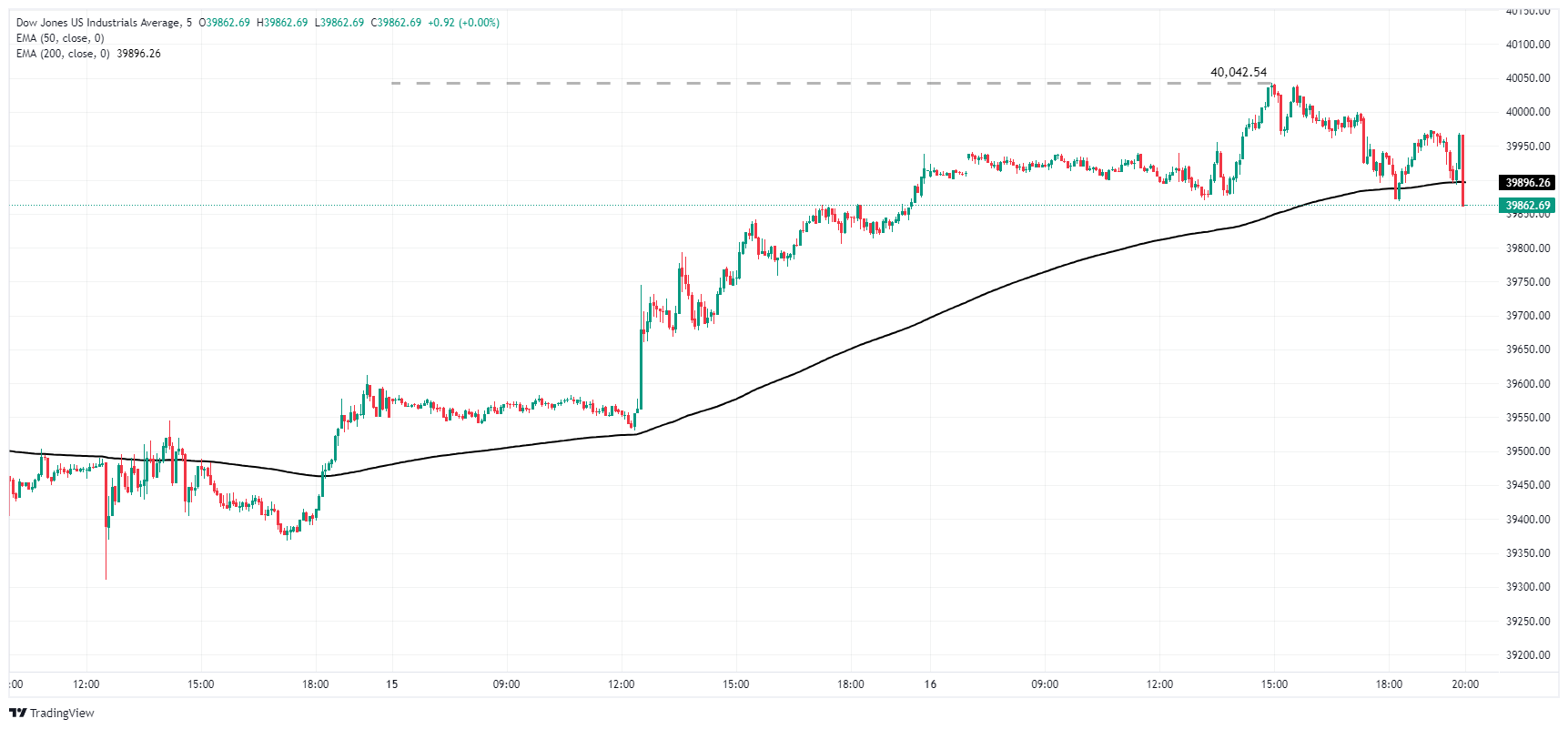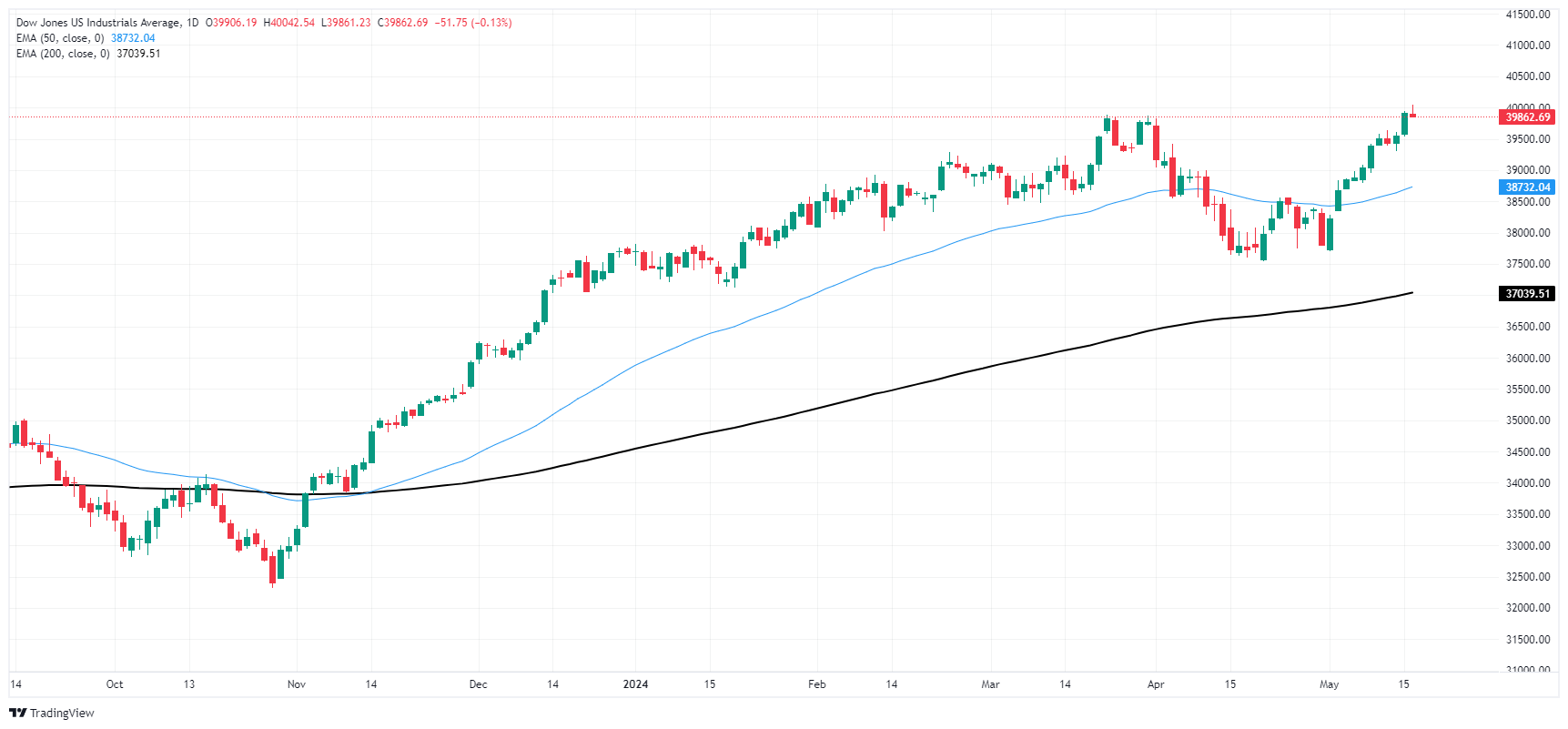- Dow Jones clips into a new record high on Thursday.
- Data calendar remains thin, Fedspeak dominates news cycle.
- Despite record bids, Dow Jones gains remain slim.
The Dow Jones Industrial Average (DJIA) pierced the 40,000 major price level on Thursday after equities floated higher early during the US session amidst a thin data calendar. Stock indexes reached fresh all-time highs following a midweek US inflation print showing price growth continues to cool, sparking fresh hope for Federal Reserve (Fed) rate cuts. However, Fedspeak weighed on risk appetite, and stock indexes broadly ended Thursday lower.
Read more: Fed officials still need further conviction regarding inflation
Despite easing headline inflation figures, Fed officials continue to thread the needle on expectations, highlighting the central bank’s neutral stance until data further confirms that current policies are working to ease inflation. Investors are hesitating as Fedspeak weighs on risk sentiment, however rate markets are still pricing in 70% odds of at least a quarter-point cut from the Fed in September according to the CME’s FedWatch Tool.
Dow Jones news
Exactly half of the Dow Jones’ constituent securities ended in the red on Thursday, crimping overall gains for the major equity index. Cisco Systems Inc. (CSCO) fell -2.71% to $48.33 per share as investors pare back over-excitement in the tech company after stellar third-quarter revenue reporting.
On the top side, Walmart Inc. (WMT) soared nearly 7% on Thursday, gaining 4.17 points to hit $64.00 per share at the closing bell. Walmart surged after beating quarterly earnings and revenue forecasts as the commerce giant challenges Amazon as an online retailer after Walmart’s e-commerce sales grew 22% in the US.
Dow Jones technical outlook
The Dow Jones broke north of 40,000.00 on Thursday, reaching a new all-time high of 40,042.54 before investors pulled back midway through the US market session. The DJIA has retreated to the 39,900.00 region, but bidding pressure remains close to the surface.
Despite Thursday’s post-peak hesitation, the DJIA remains firmly bullish, having closed in the green for all but one of the last ten consecutive trading sessions. The Dow Jones is up 6.65% bottom-to-top in 2024, and trading well above the 200-day Exponential Moving Average (EMA) at 37,020.70.
Dow Jones five minute chart
Dow Jones daily chart
Dow Jones FAQs
The Dow Jones Industrial Average, one of the oldest stock market indices in the world, is compiled of the 30 most traded stocks in the US. The index is price-weighted rather than weighted by capitalization. It is calculated by summing the prices of the constituent stocks and dividing them by a factor, currently 0.152. The index was founded by Charles Dow, who also founded the Wall Street Journal. In later years it has been criticized for not being broadly representative enough because it only tracks 30 conglomerates, unlike broader indices such as the S&P 500.
Many different factors drive the Dow Jones Industrial Average (DJIA). The aggregate performance of the component companies revealed in quarterly company earnings reports is the main one. US and global macroeconomic data also contributes as it impacts on investor sentiment. The level of interest rates, set by the Federal Reserve (Fed), also influences the DJIA as it affects the cost of credit, on which many corporations are heavily reliant. Therefore, inflation can be a major driver as well as other metrics which impact the Fed decisions.
Dow Theory is a method for identifying the primary trend of the stock market developed by Charles Dow. A key step is to compare the direction of the Dow Jones Industrial Average (DJIA) and the Dow Jones Transportation Average (DJTA) and only follow trends where both are moving in the same direction. Volume is a confirmatory criteria. The theory uses elements of peak and trough analysis. Dow’s theory posits three trend phases: accumulation, when smart money starts buying or selling; public participation, when the wider public joins in; and distribution, when the smart money exits.
There are a number of ways to trade the DJIA. One is to use ETFs which allow investors to trade the DJIA as a single security, rather than having to buy shares in all 30 constituent companies. A leading example is the SPDR Dow Jones Industrial Average ETF (DIA). DJIA futures contracts enable traders to speculate on the future value of the index and Options provide the right, but not the obligation, to buy or sell the index at a predetermined price in the future. Mutual funds enable investors to buy a share of a diversified portfolio of DJIA stocks thus providing exposure to the overall index.
Information on these pages contains forward-looking statements that involve risks and uncertainties. Markets and instruments profiled on this page are for informational purposes only and should not in any way come across as a recommendation to buy or sell in these assets. You should do your own thorough research before making any investment decisions. FXStreet does not in any way guarantee that this information is free from mistakes, errors, or material misstatements. It also does not guarantee that this information is of a timely nature. Investing in Open Markets involves a great deal of risk, including the loss of all or a portion of your investment, as well as emotional distress. All risks, losses and costs associated with investing, including total loss of principal, are your responsibility. The views and opinions expressed in this article are those of the authors and do not necessarily reflect the official policy or position of FXStreet nor its advertisers. The author will not be held responsible for information that is found at the end of links posted on this page.
If not otherwise explicitly mentioned in the body of the article, at the time of writing, the author has no position in any stock mentioned in this article and no business relationship with any company mentioned. The author has not received compensation for writing this article, other than from FXStreet.
FXStreet and the author do not provide personalized recommendations. The author makes no representations as to the accuracy, completeness, or suitability of this information. FXStreet and the author will not be liable for any errors, omissions or any losses, injuries or damages arising from this information and its display or use. Errors and omissions excepted.
The author and FXStreet are not registered investment advisors and nothing in this article is intended to be investment advice.
Recommended content
Editors’ Picks

EUR/USD Gains look limited by 1.1570 Premium
EUR/USD trades well on the defensive for the second day in a row, revisinting the mid-1.1300s on the back of the continuation of the upside impulse in the US dollar. The move followed firmer US PMI data and news indicating the White House may be considering tariff cuts on Chinese imports.

GBP/USD deflates to the sub-1.3300 area, USD bulls prevail
GBP/USD remained on the back foot Wednesday, slipping below the 1.3300 level as the Greenback gained further traction. The Dollar’s solid performance was supported by strong US data and fading concerns over a renewed escalation in the US–China trade dispute.

Gold corrected extreme conditions, struggles around $3,300
Gold extended its decline on Wednesday, slipping below the $3,300 mark per troy ounce in response to reports from the media suggesting the Trump administration is weighing tariff reductions on Chinese goods, a news that revived hopes of easing trade tensions and reduced demand for the yellow metal as a safe-haven asset.

Bitcoin bullish momentum builds as premium exceeds 9% for first time in three months
Bitcoin price is extending its gains, trading above $94,000 at the time of writing on Wednesday, following a two-day rally of 9.75% so far this week. BTC rally gathers momentum as trade war fears ease, following US President Donald Trump’s downplaying of tensions with China.

Five fundamentals for the week: Traders confront the trade war, important surveys, key Fed speech Premium
Will the US strike a trade deal with Japan? That would be positive progress. However, recent developments are not that positive, and there's only one certainty: headlines will dominate markets. Fresh US economic data is also of interest.

The Best brokers to trade EUR/USD
SPONSORED Discover the top brokers for trading EUR/USD in 2025. Our list features brokers with competitive spreads, fast execution, and powerful platforms. Whether you're a beginner or an expert, find the right partner to navigate the dynamic Forex market.



